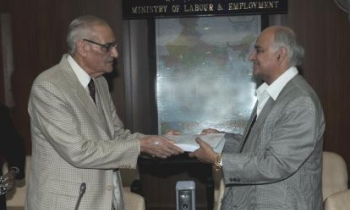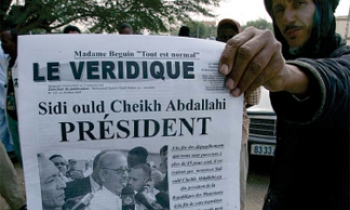NEW DELHI (AFP) - The news media may be in decline in the West but it's boom time in India where journalists are hopscotching from one job to another, picking up fatter pay checks on the way.
Indian media managers say they are scrambling to recruit staff amid a rush of new publications and television stations. Talk among journalists of 40 to 50 percent pay hikes for switching jobs is becoming the norm.
"It's a great time to be a journalist ... and a hard time for managers. The mood seems to be if you get more money -- jump," said George Mathai, deputy editor of the Calcutta Telegraph, a top national daily.
It's all a far cry from the West where television stations, newspapers and magazines are laying off staff in the face of falling audiences, dwindling circulations and shrinking advertising revenues.
Since the start of the year, two news television channels have been launched -- CNN-IBN and Times Now -- bringing to 40 the number of TV news channels on the air, many broadcasting in regional languages.
"Hiring is only going to get more difficult because new publications keep opening and existing publications are invading each other's turf. It (the competition for talent) will only intensify in months ahead," Mathai said.
The TV launches followed two new newspapers -- the Daily News and Analysis, or DNA, and the Mumbai Mirror -- and an edition of the Delhi-based daily Hindustan Times that hit the streets in India's financial capital Mumbai last year.
The frenzy shows no signs of slowing.
Earlier this year, leading media house HT Media, publisher of the Hindustan Times, said it was starting up a business newspaper in New Delhi.
It has also teamed up with another market leader, the Times of India group, with plans to launch a New Delhi newspaper despite the fact they both already publish dailies in the city -- a move seen making it harder for rivals to enter their turf.
National news magazine Outlook has launched a business magazine. News magazine India Today has said it will start a daily newspaper in New Delhi early next year. There are reports that DNA will also launch an edition in the capital.
There has also been a plethora of new upwardly mobile lifestyle and travel magazines catering to India's increasingly prosperous middle class and newspapers have added supplements ranging from home interiors to finance.
-- Rising demand for journalists sees salaries soar --
The rush of publications has created a fierce battle for staff with some newspapers having walk-in interviews.
"With more magazines, newspapers and tabloids being launched, the only way to cobble together a team of journalists is by poaching from those that have existed for a while," said Kishore Singh, senior associate editor at the Business Standard, a leading business newspaper.
"And the only way to do it is to lure them away by offering them higher designations and more lucre," said Singh, adding: "The situation is so bad I am interviewing every week."
Such is the frenzy that "a correspondent can be a feature writer next week in a just-launched publication, a bureau head a fortnight later in a soon-to-be launched publication and might well return a month from now to his old newspaper" with a much fancier title, Singh said.
"It's an unprecedented period for the media," Bhaskhar Rao, chairman of the New Delhi-based Centre for Media Studies. "Some news outlets are also hoarding staff in case they want to launch a product or fear they may lose staff."
Driving the media spurt in the country of more than one billion people is a booming economy which has created a surge in advertising.
There is also a seemingly unquenchable thirst for information among the increasingly prosperous middle class estimated to number around 300 million.
"There's an urge to know is what is happening," said Rao.
"The televisions have added to the print media -- what we call the 'appetiser effect,' people see it on television and they then want to read more about it later," he said.
Media analysts say with increasing affluence Indians have become hungry for information.
"The Indians are into knowledge-seeking mode -- which house should I buy, what kind of bank loan is best, where can I take my family on holiday, what's the best soap," said Siddartha Mukherjee, communications director at Bombay-based TAM Media Research.
"Someone who was reading one magazine before, now is reading two or three because he wants more information on what to buy," he said.
-- Circulation figures Western editors can only dream of --
Newspaper circulation figures would make any editor in the West drool.
Some 204 million Indians read daily newspapers, according to the National Readership Studies Council, which adds there is "still significant scope for growth, as 359 million people who can read and understand any language do not read any publication".
The Times of India, the country's largest English-language daily, has a circulation of 7.4 million, while the Hindi language newspapers, Dainik Jagran and the Dainik Bhaskar, are the two top selling newspapers overall with readership of over 20 million each.
"The appetite for reading (in India) is growing along with the increasing literacy rate, and advertising is growing week by week. No wonder the world's newspaper entrepreneurs are looking avariciously at an untapped market with apparently limitless possibilities," wrote London Guardian media columnist Roy Greenslade, referring to India's media boom.
"How soon before British journalists flock to Delhi and Mumbai?" Greenslade asked, referring to bleak job prospects facing British reporters at home.
One senior media manager who asked not to be named said his paper was offering mid-year increments and loyalty bonuses to keep people.
He said staff leaving the paper were not going to stay for 20 or 25 percent hikes which were considered "peanuts".
"They are getting 40 to 45 percent rises to go to another newspaper, then sometimes during their probation period they get the offer of a rise of a similar nature somewhere else," he said.
Indian media salaries are still low by Western standards -- rookies out of journalism school get around 15,000 rupees (335 dollars) a month -- but the salaries are catching up at more senior levels.
Also fuelling the media explosion has been easing of foreign media ownership laws in 2002 to allow 26 percent foreign ownership. Before then no foreign investment was allowed in the sector in a bid to protect the "national interest".
Even this small opening has brought foreign media investors rushing into India, keen to tap potential readers, listeners and viewers amid slumping markets at home.
The Outlook Group has tied up with French publisher Group Marie Claire to publish the international women's magazine "Marie Claire" from India while its rival, the India Today Group, already publishes two other international women's titles, "Cosmopolitan" and "Good Housekeeping".
These all have Indian content so they too are scooping up staff.
In the midst of this, firms are recruiting journalists to edit and write for Western publications which are outsourcing editorial work to take advantage of cheaper wages.
Unions in the West deride such practices as "remote control journalism" but it is catching on in a big way, says Rao.
"Urgent requirement for business writers" with "exposure and experience in editing/writing for US/International media," said an advertisement on dotcom recruiter MonsterIndia.com.
Global news and financial information agency Reuters has hired some 100 Indian journalists to work on routine US financial stories, citing significantly lower costs and the chance to free its US reporters to do more in-depth reporting.
A survey by the Paris-based World Newspaper Organisation of 350 newspapers in Europe, Asia and the United States found all expected outsourcing to increase.
How long can the Indian media boom last?
A long time, says Tam's Mukherjee.
"The media sector is just at the takeoff stage," he says. "If you look at all mediums, print, television, Internet, they are just reaching 50 percent of the Indian population. The other 50 percent are 'media dark'."









